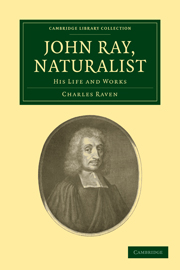Book contents
- Frontmatter
- Contents
- Preface
- Introduction
- ABBREVIATIONS
- Chapter I Boyhood and Youth
- Chapter II At Cambridge University
- Chapter III First Studies in Science
- Chapter IV The Cambridge Catalogue
- Chapter V The Years of Travel
- Chapter VI The English Catalogue
- Chapter VII The Years of Varied Output
- Chapter VIII The Structure and Classification of Plants
- Chapter IX The History of Plants
- Chapter X The Flora of Britain
- Chapter XI Last Work in Botany
- Chapter XII The Ornithology
- Chapter XIII The History of Fishes
- Chapter XIV Of Mammals and Reptiles
- Chapter XV The History of Insects
- Chapter XVI Of Fossils and Geology
- Chapter XVII The Wisdom of God
- Conclusion
- Index
Chapter XV - The History of Insects
Published online by Cambridge University Press: 07 September 2010
- Frontmatter
- Contents
- Preface
- Introduction
- ABBREVIATIONS
- Chapter I Boyhood and Youth
- Chapter II At Cambridge University
- Chapter III First Studies in Science
- Chapter IV The Cambridge Catalogue
- Chapter V The Years of Travel
- Chapter VI The English Catalogue
- Chapter VII The Years of Varied Output
- Chapter VIII The Structure and Classification of Plants
- Chapter IX The History of Plants
- Chapter X The Flora of Britain
- Chapter XI Last Work in Botany
- Chapter XII The Ornithology
- Chapter XIII The History of Fishes
- Chapter XIV Of Mammals and Reptiles
- Chapter XV The History of Insects
- Chapter XVI Of Fossils and Geology
- Chapter XVII The Wisdom of God
- Conclusion
- Index
Summary
The Phalaenae are so numerous that I despair of coming to an end of them, much less of discovering the several changes they go through from the egg to the papilio, and describing the erucae and aureliae of each.
John Ray to William Derham, 6 September 1704, Correspondence, p. 455.One last department of the great undertaking to which Ray had dedicated himself on leaving Cambridge and to which his friend Dr Tancred Robinson was constantly exhorting him still remained unfulfilled. He had published the Synopsis of British Plants in 1690 and the supplementary Sylloge of European Plants in 1694. The Synopsis of Animals and Reptiles had appeared in 1693 and that of Birds and Fishes had been sent to Dr Robinson on 29 February 1694. There remained the Insects—a tribe including, in those days, everything from an amoeba to an earthworm; and to these he turned with an energy amazing but characteristic.
It is indeed an almost heroic achievement. He was living in considerable poverty at Black Notley, remote from any libraries or collections and from contact with friends and fellow-workers. He was maintaining his other interests—in theology, in botany, and the general field of natural studies. He was constantly pressed to fresh labours by the importunity of his friends, and in 1693 edited his Collection of Curious Travels and Voyages at the request of Charles Hatton and Hans Sloane.
- Type
- Chapter
- Information
- John Ray, NaturalistHis Life and Works, pp. 388 - 418Publisher: Cambridge University PressPrint publication year: 2009First published in: 1942



